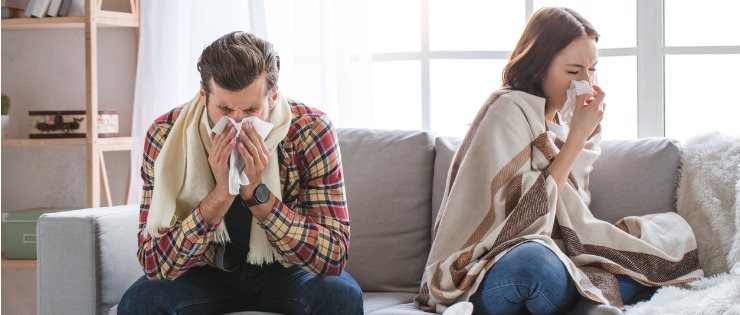
No one likes getting a cold or flu. If there is anything we can do to reduce the effects of the dreaded bug, we’ll try it. Some myths and wives-tales have been circulating, much like a cough on a packed bus, for decades.
So if you have ever wondered if your mum is right about going out with wet hair or if there is any merit to whipping up a healing batch of chicken soup, we’re busting seven of the most common myths about cold and flu.
Myth #1 You can catch a cold or flu from the flu vaccine
The flu vaccination is the most effective measure to protect against influenza. Some people have mild reactions to the flu shot which they think is the flu or a cold. According to Choice, the most common responses to the flu shot include redness, swelling at the injection site, low fever and muscle aches and tiredness. It’s the immune system reacting to the vaccination that causes these symptoms which makes some people think they have contracted a mild dose of the flu.
The flu virus in the vaccine is inactive so you aren't injected with a live virus that can cause infection. With so many cold and flu viruses circulating when you have the flu jab, you might still pick up one that has nothing to do with the vaccine.
It takes 1-2 weeks after vaccination to be entirely immune, so if you suffer from the virus soon after the injection, it’s likely you were going to get sick whether you had the vaccine or not. The vaccine may be responsible for the reaction symptoms you might be experiencing, but it didn’t cause you to get a cold. Immunisation only reduces your chance of getting the flu; it doesn’t eliminate the risk. It is thought that the vaccine helps to reduce the severity of the flu if you do contract it.
Myth #2 Feed a cold, starve a fever
It’s a saying that has been around for years but does it have any merit?
Feeding a cold may have something to do with making sure you stay hydrated when feeling sick. To help with recovering from a cold, you need to avoid becoming dehydrated. Drinking plenty of fluids and eating foods with a high water content will keep you hydrated.
A Journal of Nutrition study in 2008 found that mice exposed to the flu took longer to recover if they were on a low-calorie diet. They were also more likely to suffer ill effects. This suggests the last thing you want to do is reduce your food intake when you have a fever!
A cold or flu may make you lose your appetite, but you should keep eating small portions of nutritious foods to maintain your calorie intake. You are less likely to become dehydrated, and if humans are anything like the mice in the study, you may recover quicker.
The famous chicken soup remedy is ideal for keeping you hydrated. The bone broth in the soup also breaks up the mucous and reduces inflammation in the respiratory tract. Garlic stimulates the immune system and can help you recover from a cold quicker. A steaming hot cup of tea or a honey and lemon drink can help relieve nasal congestion.
Myth #3 Getting cold can give you a cold
Unless you are so wet and cold that you suffer the effects of hypothermia, you are not going to get sick from getting caught in a shower of rain.

Colds and the flu are caused by bacterial viruses passed on from person to person. While colds and the flu are more prevalent in the colder months of the year, you have an increased chance of catching either one because you are indoors more and close to other people. You are more likely to come in contact with the virus on indoor surfaces like door knobs and light switches than if you were outside in the fresh air. It’s easier for viruses to spread from people sneezing and coughing in an enclosed indoor space.
So, going out with wet hair and getting sick is another old wives’ tale. For many years, people have been making sure they dry their hair thoroughly, so their damp head doesn’t cause them to catch a cold. When people feel a cold coming in, they will think back to how they might have caught it. Remembering a time they were cold or wet is often labelled as the culprit. Feeling cold won’t make you sicker either, just more uncomfortable.
Stay warm and dry during winter for comfort rather than avoiding a cold. What you need to do is keep up your immune system so it can fight off cold and flu viruses. Eating a healthy diet, getting enough sleep and regular daily exercise will help you stay healthy and strong to fight off infections you come in contact with.
Myth #4 A cold can become the flu
A cold doesn’t become the flu, and similarly, the flu doesn’t reduce into a cold. Colds and flu are two different viruses with similar symptoms. The common cold symptoms usually include coughing and sneezing with a runny or stuffy nose while the flu can include a high temperature, body aches, dry cough and extreme tiredness and hospitalisation when flu complications occur.
Your cold may become worse over a few days. It may start out with just sneezing and a runny nose, but as other symptoms develop and become more severe, people can incorrectly think their cold has turned into the flu.
People may suffer the same symptoms every time they experience a cold, or they may have a different set of symptoms with each infection.
Symptoms of potentially dangerous illnesses requiring medical attention include neck or head stiffness, a deep rattling cough and high fever. If the severity of any symptoms gets worse suddenly, see your doctor.
Myth #5 You are Only Contagious for the First Few Days of a Cold
You might feel like you are getting over your cold, but it doesn’t mean you can’t pass it on to other people around you. The contagious phase of a cold for an adult can last as long as seven days. It can be even longer in children with weak immune systems.
Unfortunately, you can be contagious one day before any cold symptoms appear so you can unwittingly pass on the virus. The incubation period for the flu is even longer, from one to four days. Complications of the flu such as pneumonia can extend the contagious period for one to two weeks.
Cold and flu viruses spread through infected droplets in the air. The droplets are spread through coughing, sneezing and talking. Touching an infected person’s skin can transmit the virus. Cold viruses can also live on surfaces for several hours so if you touch a contaminated surface then your nose or mouth, you are at risk.
We have known the risk for many years. In 1982 the American Journal of Epidemiology published a study that showed half of the healthy young adults that touched a cup handle infected with the rhinovirus then touched their face came down with a cold.
Your best defence from catching a cold or flu is to wash your hands regularly with soap and running water.
It isn’t called the common cold for anything, the virus is everywhere.
Myth #6 Avoid Eating Dairy Products When You Have a Cold
Not consuming dairy when you have a cold or the flu is another long-standing wives' tale. It is claimed that dairy products create more mucus in the body. It is most probably related to the feeling of thick phlegm in the throat, but there isn’t any actually more phlegm created after eating dairy.
Yoghurt is actually recommended while fighting a cold because of the nutrients it contains. One cup of yoghurt contains almost 20% of the recommended daily intake of zinc for an adult - zinc supports healthy immune system function. Probiotics in yoghurt can also improve immune function. It’s an excellent source of vitamin A, calcium and potassium which provide the nutritional support your body needs to fight an infection.

Ice cream or frozen custard might soothe a sore throat, and if you aren’t eating normal meals, these treats may supply some of the calories you are missing albeit with less nutrition that your usual diet provides. Milk has received a bad rap for increasing mucous for cold sufferers, but research has shown there is no difference after drinking cow or soy milk.
So, next time you have a cold, consider following your chicken soup meal with a bowl of yoghurt for dessert.
Myth #7 Hand Sanitiser is Better than Washing your Hands
The massive increase in the number of hand sanitisers available in restaurants, hospitals, offices, supermarkets and doctors’ surgeries has led to people believing they are the best defence against the spread of viruses. However, studies have shown that washing your hands with soap and running water is the superior method. It might be old-fashioned, but it still works. Hand sanitizer is just more convenient in these settings.
Sanitising gel is also less useful if your hands are dirty whereas water has more chance of removing the dirt. The quality of hand sanitiser also matters. To be effective in stopping the spread of infectious diseases, they must contain at least 60% alcohol. Before buying a bottle of sanitiser to carry around with you, check the alcohol content.
A 2005 study showed there was no significant difference in the spread of colds in families that used hand sanitiser and those families that didn’t. It’s probably best we teach our kids from a young age how to wash their hands properly and save the sanitiser for times where we don’t have access to a tap.
Separating Fact from Fiction
It’s easy for cold and flu myths to get in the way of the truth. Most adults will suffer between two and four colds every year, so if there is something we can do to avoid a cold or reduce the severity, we’re willing to do it. Over the years a half-truth or favourite wives’ tale becomes gospel, and we’re eager to believe anything if it means getting up off our sick bed and resuming a healthy life.
But don’t be in too much of a rush to get back to normal. By staying home from work or school, you aren’t infecting other people. If you have the flu, chances are you can’t even get out of bed to go to work. Give your body plenty of rest to recover quicker.
If the wives’ tales don’t make you feel better, there are always cold and flu medications available over the counter. Always speak to your pharmacist or doctor if your cold or flu symptoms persist.